A COMPARISON OF THE ORIGINAL 1843 FORM OF 'NEW MICROSCOPE' OF POWELL & LEALAND WITH AN EXAMPLE OF THEIR LATER 'No 3' MODEL DATED 1867
MAKER: POWELL & LEALAND
Please Click On Any Picture for a Larger Version
This page is devoted to a comparison between the original P & L 'New Microscope' of 1843 and the later 'No 3' model(this example dated 1867), with which it is sometimes confused. The No 3 was, by the time its design was called a No 3, about the same size as the 'New Microscope' of 1843, but smaller than the much larger No 1 and No 2, and had changed in many ways compared to the 'New Microscope' of 1843. The first No 3 (called that because there was then both a No 1 and No 2), was apparently made about 1860. The exact details of this initial form of the officially-named No 3 are apparently unknown. The earliest known example of No 3 is often considered the version from 1865, an example of which is found in the Billings Collection in Washington, D.C. This version did not yet have a rack and pinion substage, despite the fact that it had appeared much earlier on the larger 'Improved First Class' model of the mid-1850's.
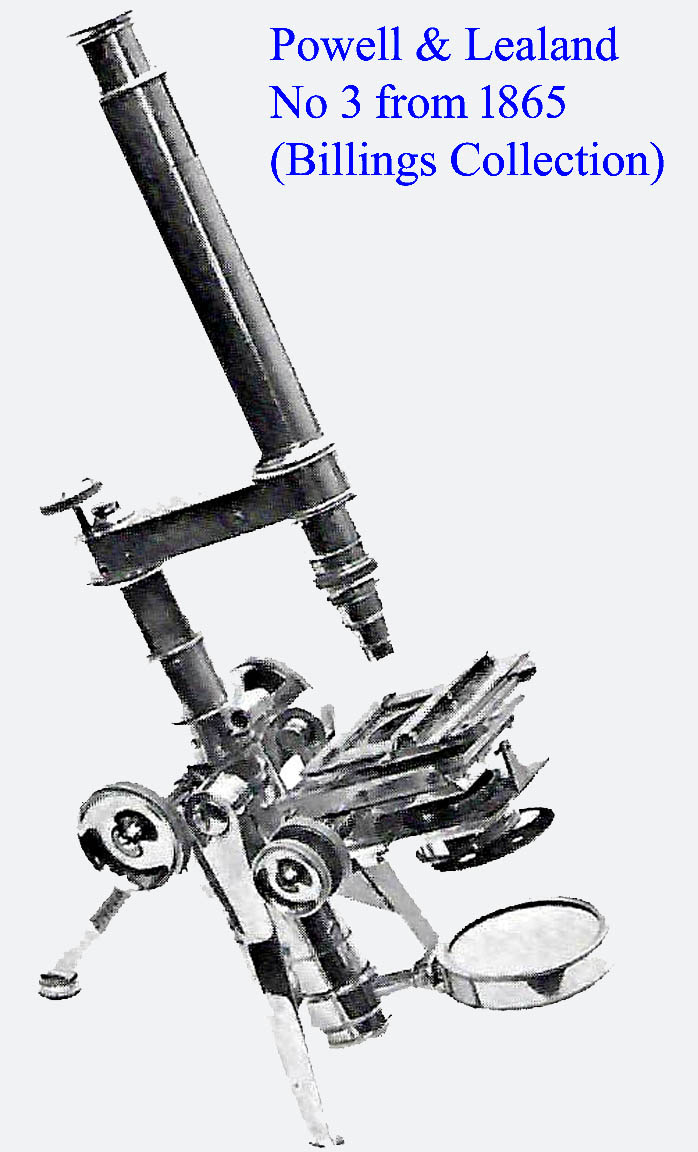 By 1865, as shown in the example in the Billings collection(left), the microscope had no struts from the arm to the optical tube, and for the first time, a much thinner stage. The understage accessories, instead of using a bayonet fitting, now attached to the bottom of the stage by sliding in on a plate.
By 1865, as shown in the example in the Billings collection(left), the microscope had no struts from the arm to the optical tube, and for the first time, a much thinner stage. The understage accessories, instead of using a bayonet fitting, now attached to the bottom of the stage by sliding in on a plate.
Between 1865 and 1869, what were to be the final improvements to the No 3 were added. These first included the rack and pinion substage, and then the ability to center the substage. As already mentioned above, it should be noted that, in the meantime, a rack and pinion substage had already been added to the evolving larger "improved" model no later than 1856.
The most important changes included:
1. A much thinner stage(first provided in the 1860's) without the built-in spring loaded top plate(known as a safety stage).
2. A separate rack and pinion substage(added after 1865).
3. Provision for centering the substage(apparently added around or after 1867) and,
4. A drawtube
5. Longer arm, stage, and stem for the mirror, moving the optical axis further forward from the limb.
6. Later versions had an added double articulation for the mirror.
The images shown here below illustrate some of the other changes in the design between the original 1843 model(left side of the side-by-side images), and the later No 3(this example, of 1867, right side of the side-by-side images). These changes included the thickness of the stage, changes in the design of slide-holding parts, a change in the location of the angling of the two front feet, a change in the way the fitting on the limb to hold accessories was attached to the limb, a longer piece above the stage to receive the bar, the mechanism for stopping the inclination in the horizontal and vertical positions, and the use of 'top-hat' eyepieces. The top-hat eyepieces still retained the lacquered brass ring for the upper part of their barrels however.
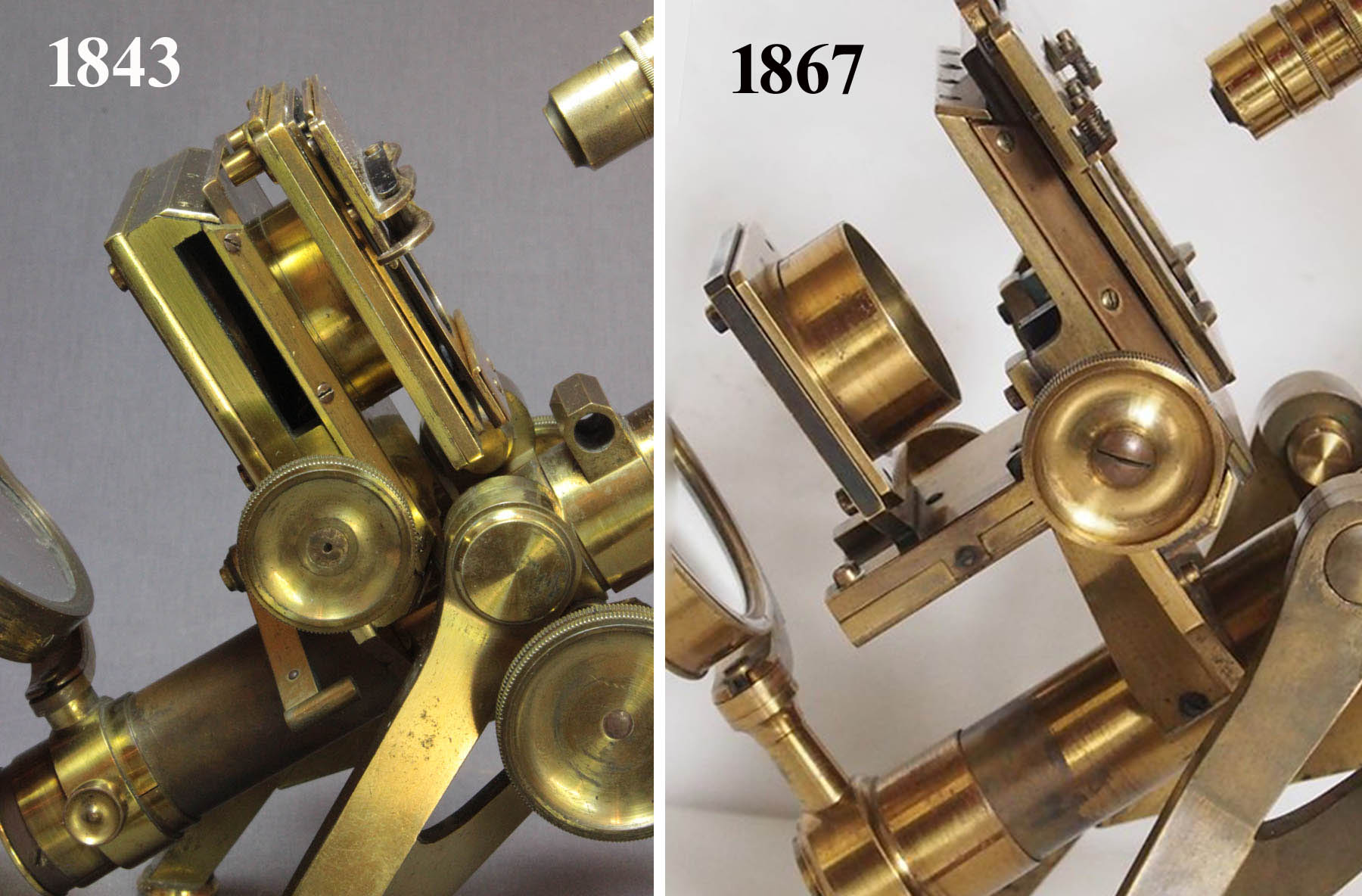
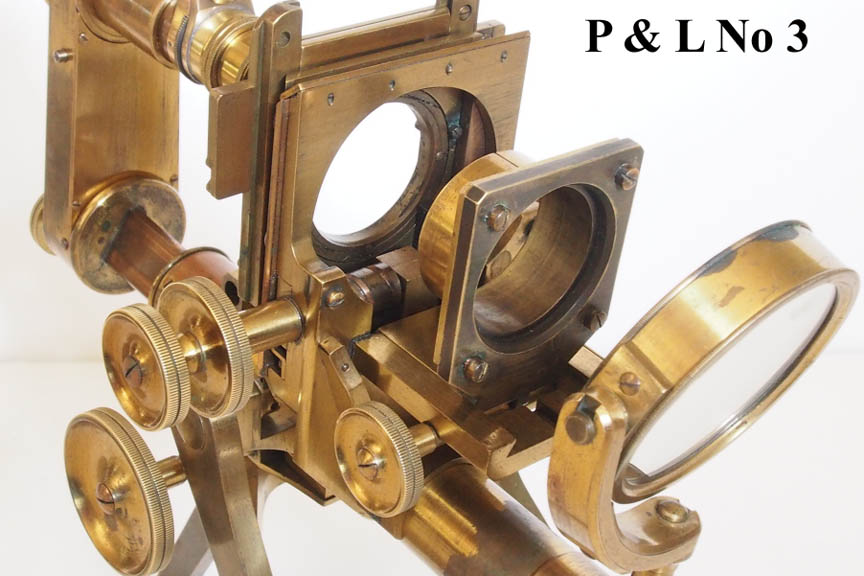
The mechanical stage itself is thinner on the No 3. This is achieved in two ways. Firstly, the top plate on the mechanical stage was no longer a sprung double-plate safety-stage, and secondly, the axis of the controls for the stage is now under the main stage plate(instead of above it), and the housing for the concentric axles of the controls(right) does not extend all the way forward. Thus the total thickeness of the stage under the slide is considerably reduced.
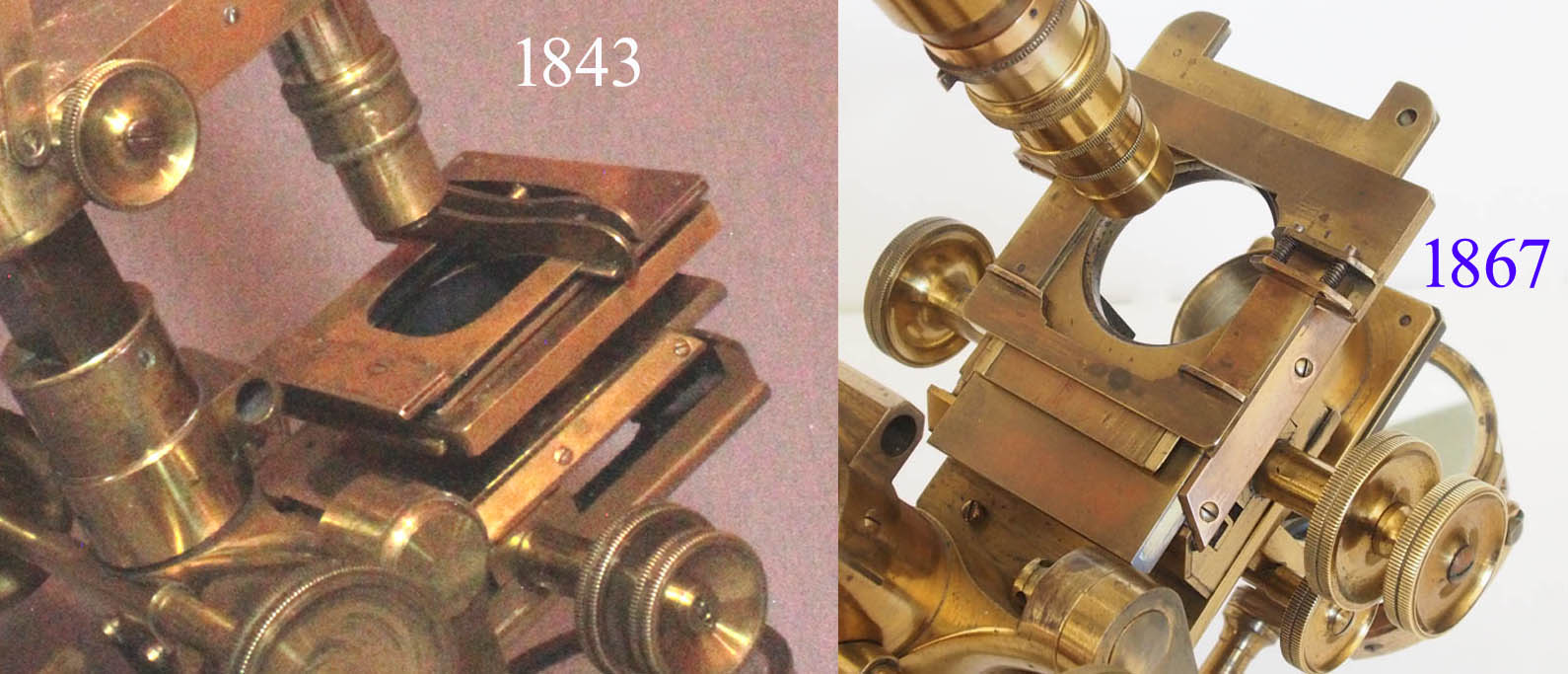
The slide holding parts on top of the stage changed from a single wide sprung slide holder to a form with two small plates sprung on the right and left sides. In addition, instead of a short flat fixed bar, with an accessory bar to increase the height of the gripping parts, the fixed bar became L-shaped to permanently provide taller gripping points.
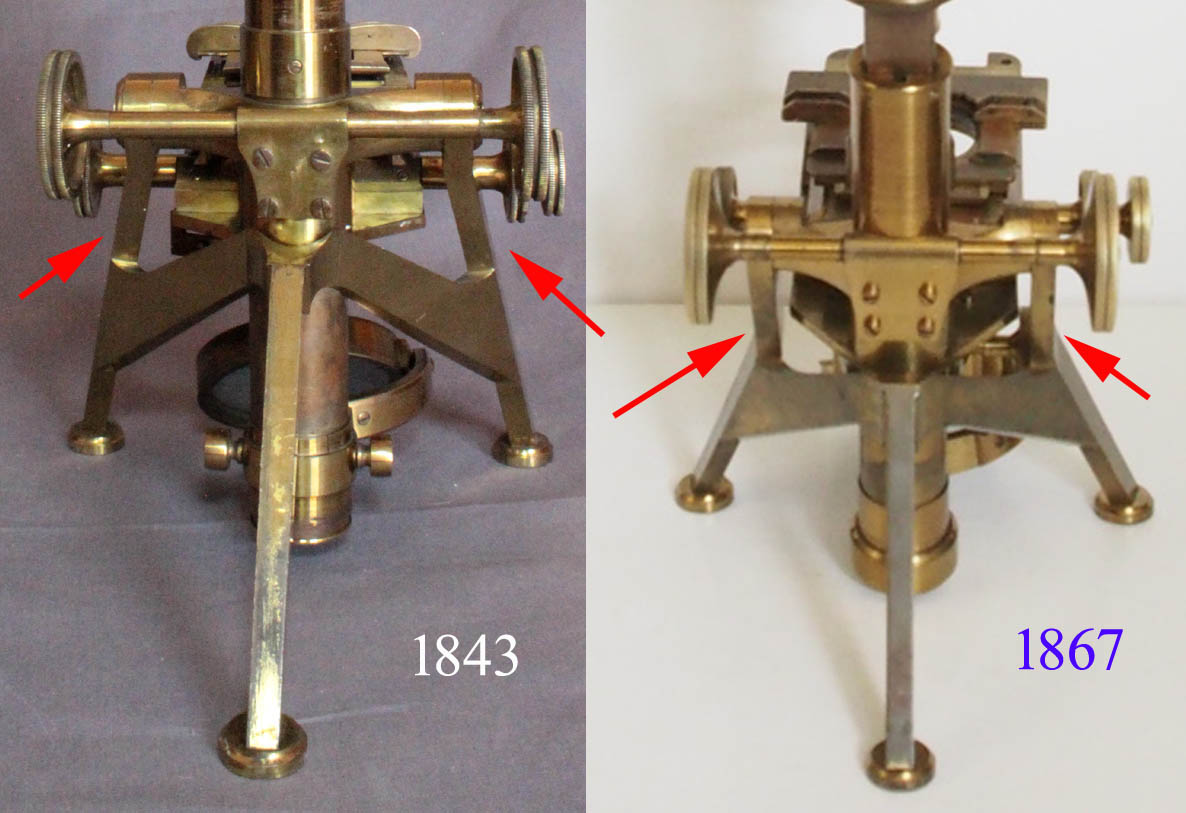
The changes in the tripod are subtle. In the 1843 version, the front feet angled away starting at the inclination joint, but in the number three these two feet extended downward vertically from the joints before angling away.
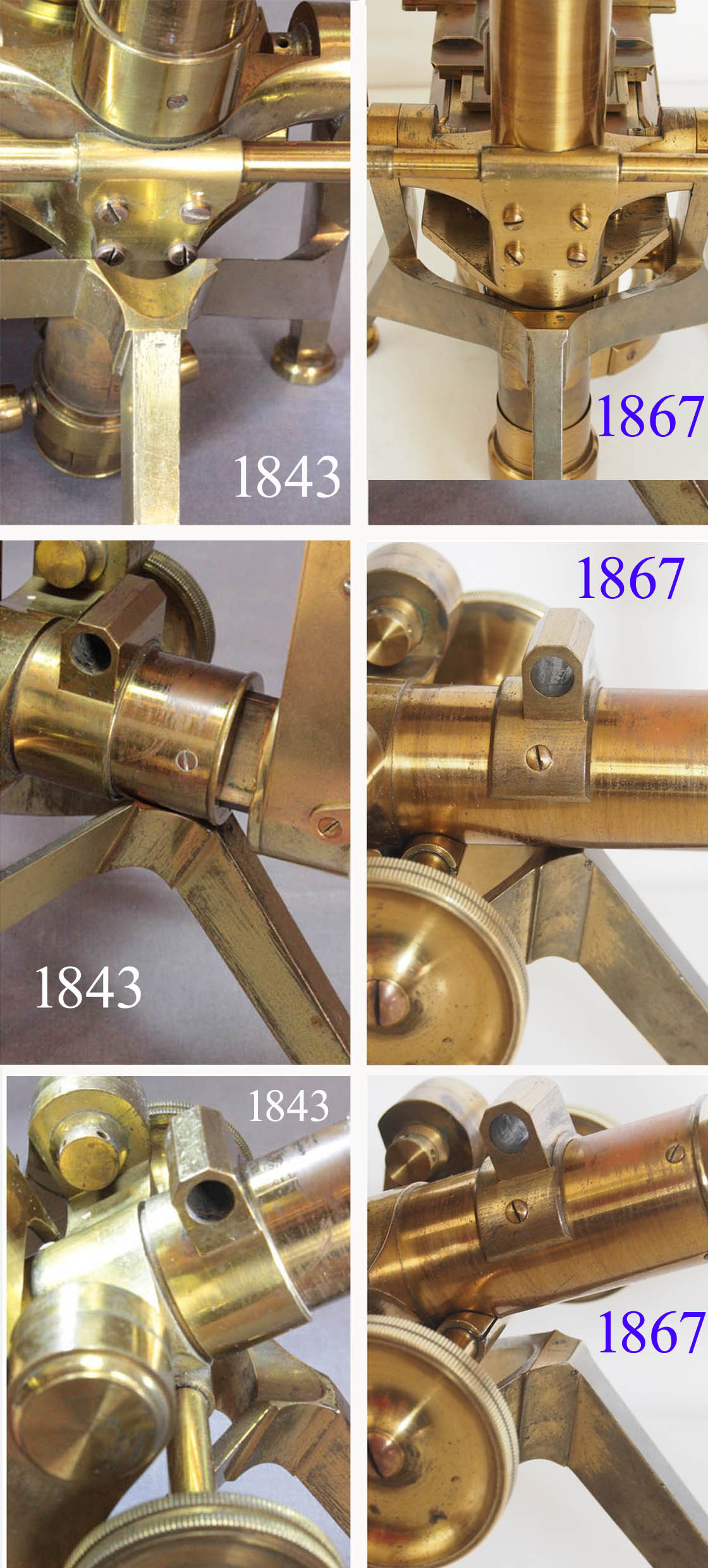
Shown in these images are the inclination positions of the 1843 model(left) and No 3(right). In the No 3, the tripod itself was no longer the 'stop' in the vertical and horizontal positions. This was apparently integrated inside the inclination mechanism itself. Although not visible in the images, when the No 3 was in either of the these two positions, a tiny space remains between the limb and the tripod, preventing damage to both the tripod and the limb that might have occurred in the earlier model when slammed up against the tripod. Note also that the profile of the top of the tripod was no longer round in the No 3.
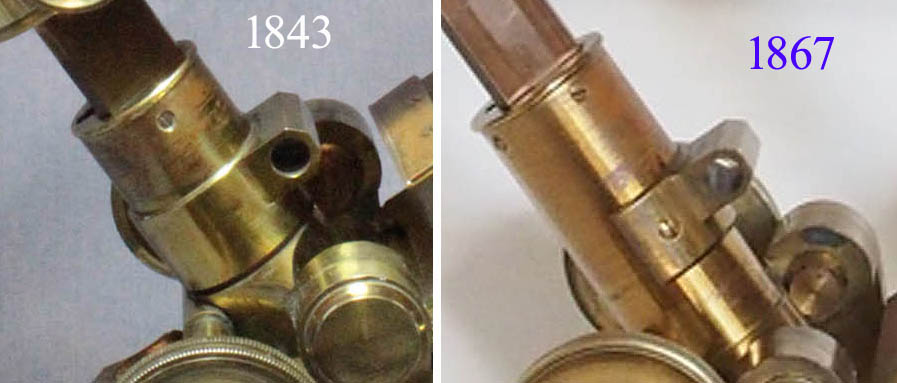
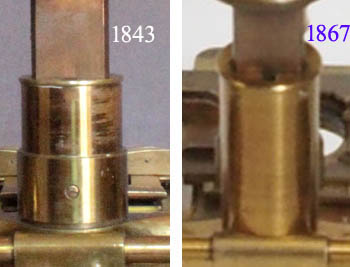 Both the 1843 model and the later No 3 had a round fitting attached to the limb to accept long limb-mounted accessories. On the 1843 model, this fitting was part of a ring fitting around the limb. Later on the No 3, this was changed to a part circular fitting that was screwed into the front of the limb. Furthermore, the length of the part of the limb accepting the bar with the rack on it extended further above the inclination joints than in the 1843 model.
Both the 1843 model and the later No 3 had a round fitting attached to the limb to accept long limb-mounted accessories. On the 1843 model, this fitting was part of a ring fitting around the limb. Later on the No 3, this was changed to a part circular fitting that was screwed into the front of the limb. Furthermore, the length of the part of the limb accepting the bar with the rack on it extended further above the inclination joints than in the 1843 model.
Although the supporting struts were no longer used, these had probably been abandoned about 1860, before the No 3 was called a No 3. Also changed was the type and location of fine adjustment, but likewise, this was changed in the 1840's, also before the No 3 existed as such.
Importantly, the No 3 retained the round foot pads, the same inclination mechanism design, the bar-limb construction and a very similar form of 'kettle drum' type of tripod, though with the subtle changes noted above.
The Turrell type of stage controls,including the cam-and-follower mechanism, were retained on all mechanical stages of P & L., albeit the rest of the stage itself had a much thinner design.
SUMMARY OF THE EVOLUTION OF THE No 3: As improvements in the initial 1843 model took place, transitional models appeared. Gradually, between 1843 and the 1860's several different variations of the original appeared. Each of these in turn evolved a bit further over the years, until the final versions took shape, including the larger No 1 and No 2, as well as the No 3. However the No 3 remained about the same size as the original 1843 model. It was apparently about 1860 that these were first designated No 1, No 2, and No 3 stands.
In the case of the No 3, this was characterized by a change in the stage to a thinner form; at first, instead of a bayonet fitting on the bottom of the stage, a slide-in mechanism was adopted so that accessories were attached on plates which slid on the bottom of the stage from the front, much like early James Smith microscopes. Later, this was replaced by a separate rack and pinion substage with support ring for accessories. As can be seen in the comparison images on this page of a No 3 from 1867, this ring initially had no provision for centration, but eventually this feature was added. So in the final version of the No 3, a fully developed rack and pinion substage with provision for centering, and a thinner stage became standard features. This form continued for more than 30 years.
Courtesy of Dr Joseph Zeligs, some of the approximate times some of the changes took place, based on dated examples:
1843: First P & L tripod bar limb microscope
1845: First year the front legs were angled after the straight portion
1848: Fine focus control moved to the top of the arm
1854-5: Rack & Pinion Substage first added to transitional models
Between 1860 and 1865:
a.Struts to the tube no longer present
b.Taller housing for the bar
c.Change to the thinner stage
After 1867: Centering for the substage, and articulated arm for the mirror were added.
As Budd Larue has pointed out, the No 3, then, despite its name, was not a 'third class' microscope, better fitting into the category of a 'second class' which meant the microscope had all the main features of the first class instruments but was smaller and with manual rather than geared rotation to the stage.
 By 1865, as shown in the example in the Billings collection(left), the microscope had no struts from the arm to the optical tube, and for the first time, a much thinner stage. The understage accessories, instead of using a bayonet fitting, now attached to the bottom of the stage by sliding in on a plate.
By 1865, as shown in the example in the Billings collection(left), the microscope had no struts from the arm to the optical tube, and for the first time, a much thinner stage. The understage accessories, instead of using a bayonet fitting, now attached to the bottom of the stage by sliding in on a plate. 





 Both the 1843 model and the later No 3 had a round fitting attached to the limb to accept long limb-mounted accessories. On the 1843 model, this fitting was part of a ring fitting around the limb. Later on the No 3, this was changed to a part circular fitting that was screwed into the front of the limb. Furthermore, the length of the part of the limb accepting the bar with the rack on it extended further above the inclination joints than in the 1843 model.
Both the 1843 model and the later No 3 had a round fitting attached to the limb to accept long limb-mounted accessories. On the 1843 model, this fitting was part of a ring fitting around the limb. Later on the No 3, this was changed to a part circular fitting that was screwed into the front of the limb. Furthermore, the length of the part of the limb accepting the bar with the rack on it extended further above the inclination joints than in the 1843 model.